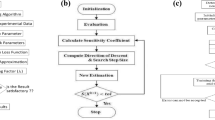Abstract
Owing to its low hydraulic conductivity, soil and bentonite mixture is applied as a liner material. However, the experimental determination of hydraulic conductivity, which is controlled by various physical, chemical and mineralogical factors, requires an expensive and time-consuming setup. In the present work, multigene symbolic, genetic programming was used to model functional relationships for hydraulic conductivity. The developed model was able to generalize highly nonlinear variations in data as well as predict system behavior from experimental observations. It was found that the predictions obtained from developed model agree well with experimental observations.







Similar content being viewed by others
References
Afzal W, Richard T (2011) On the application of genetic programming for software engineering predictive modeling: a systematic review. Expert Syst Appl 38:11984–11997
Alther GR (1982) The role of bentonite in soil sealing applications. Bull Assoc Eng Geol 19:401–409
Amir HG, Amir HA (2011) A new multi-gene genetic programming approach to non-linear system modeling part II: geotechnical and earthquake engineering problems. Neural Comput Appl 21(1):189–201
ASTM (1984) Standard test method for Methylene Blue Index of clay C 837-99. American Society for Testing and Materials, Philadelphia
ASTM (2001) Standard test method for Swell Index of clay mineral component of geosynthetic clay liners. D 5890. American Society for Testing and Materials, Philadelphia
ASTM (2002) Standard test method for particle size analysis of soils D 422-63. American Society for Testing and Materials, Philadelphia
ASTM (2003) Standard test methods for measurement of hydraulic conductivity of saturated porous materials using a flexible wall permeameter D 5084. American Society for Testing and Materials, Philadelphia
Budhu M, Campbell RF, Baumgrass L (1991) The permeability of soils with organic fluids. Can Geotech J 28:140–147
Chaipus RP (2002) The 2000 R.M. Hardy Lecture: full-scale hydraulic performance of soil–bentonite and compacted clay liners. Can Geotech J 39:417–439
Daniel DE (1984) Predicting hydraulic conductivity of clay liners. J Geotech En ASCE 110(4):465–478
David S, John M, Alex G (2004) Genetic programming within civil engineering. In: Proceedings of organisation of the adaptive computing in design and manufacture 2004 conference April 20–22 Engineers House Clifton Bristol UK
Dutta J, Mishra AK (2015) A study on the influence of inorganic salts on the behaviour of compacted bentonites. Appl Clay Sci 116–117:85–92
Faradonbeh RS, Armaghani DJ, Majid MA, Tahir MM, Murlidhar BR, Monjezi M, Wong HM (2016) Prediction of ground vibration due to quarry blasting based on gene expression programming: a new model for peak particle velocity prediction. Int J Environ Sci Technol 13(6):1453–1464
Fodor IK (2002) A survey of dimension reduction techniques, technical report. Center for Applied Scientific Computing, Lawrence Livermore National Laboratory
Gleason M, Daniel DE, Eykholt GR (1997) Calcium and sodium bentonite for hydraulic containment applications. J Geotech Geoenviron Eng 123(5):438–445
Guven A, Mustafa G (2008) Genetic programming approach for prediction of local scour downstream of hydraulic structures. J Irrig Drain Eng 134(2):241–249
Howell JL, Shackelford CD (1997) Hydraulic conductivity of sand admixed processed clay mixtures. In: Proceedings of 14th international conference on soil mechanics and foundation engineering Hamburg vol 1 Balkema Rotterdam, pp 307–310
Johari A, Habibagahi G, Ghahramani A (2006) Prediction of soil–water characteristic curve using genetic programming. J Geotech Geoenviron Eng 132(5):661–665
Koza JR (1992) Genetic programming: on the programming of computers by means of natural selection. MIT Press, New York
Kumar M, Bhatt M, Samui P (2014) Modeling of elastic modulus of jointed rock mass: gaussian process regression approach. Int J Geomech 14(3):14001-1–14001-4
Lee JM, Shackelford D (2005) Impact of bentonite quality on hydraulic conductivity of geosynthetic clay liners. J Geotech Geoenviron Eng ASCE 131(1):64–77
Masters T (1993) Practical neural network recipes in C++. Academic Press, San Diego
Mesri G, Olsen RE (1971) Mechanisms controlling the permeability of clays. Clay Clay Miner 19:151–158
Mishra AK, Ohtsubo M, Li L, Higashi T (2011) Controlling factors of the swelling of various bentonites and their correlations with the hydraulic conductivity of soil–bentonite mixtures. Appl Clay Sci 52:78–84
Mitchell JK, Soga K (2005) Fundamentals of soil behavior, 3rd edn. Wiley, New York
Narendra BS, Sivapullaiah PV, Suresh S, Omkar SN (2006) Prediction of unconfined compressive strength of soft grounds using computational intelligence techniques: a comparative study. Comput Geotech 33:196–208
Newland PL, Alley BH (1960) A study of consolidation characteristics of a clay. Geotechnique 10:62–74
Nitin M, Kwok-wing C (2006) Neural network and genetic programming for modelling coastal algal blooms. Int J Environ Pollut 28:223–238
Pratt PF (1965) Sodium methods of soil analysis part 2 chemical and microbiological properties 2nd edn. Soil Science Society of America Madison, Wisconsin, USA, pp 1031–1034
Searson D (2009) GPTIPS: genetic programming & symbolic regression for MATLAB. http://gptipss.ourceforge.net
Shang JQ, Ding W, Rowe RK, Josic L (2004) Detecting heavy metal contamination in soil using complex permittivity and artificial neural networks. Can Geotech J 41:1054–1067
Sivapullaiah PV, Sridharan A, Stalin VK (2000) Hydraulic conductivity of bentonite-sand mixtures. Can Geotech J 37:406–413
Taylor DW (1942) Research on consolidation of clays. Serial number 82. Department of Civil Engineering, Massachusetts Institute of Technology, Cambridge, Mass
Terzaghi K (1943) Theoretical soil mechanics. Wiley, New York
Yan K, Xu H, Shen G (2014) Novel approach to resilient modulus using routine subgrade soil properties. Int J Geomech 14(6):04014025
Acknowledgements
Authors acknowledge IITG for providing favorable environment during the present work.
Author information
Authors and Affiliations
Corresponding author
Additional information
Editorial responsibility: Tanmoy Karak.
Rights and permissions
About this article
Cite this article
Mishra, A.K., Kumar, B. & Vadlamudi, S. Prediction of hydraulic conductivity for soil–bentonite mixture. Int. J. Environ. Sci. Technol. 14, 1625–1634 (2017). https://doi.org/10.1007/s13762-017-1247-9
Received:
Revised:
Accepted:
Published:
Issue Date:
DOI: https://doi.org/10.1007/s13762-017-1247-9




